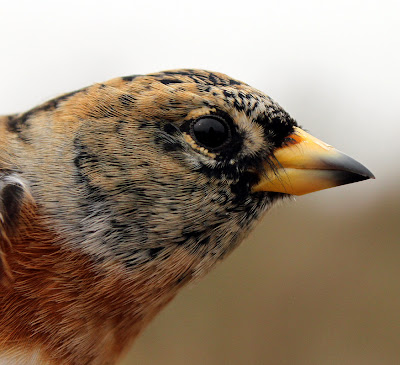What a strange day for birding. There was a bitterly cold easterly wind as the BBC said there would be, but one minute I’m out in the sunshine enjoying a good bit of birding, and then two minutes later scurrying for the car to escape horizontal snow showers. Listening to the radio and waiting for the shower to stop it seems the maritime Fylde is surrounded by snow to the north, east and south once again.
Sunny Showers
It's On The Way
Snow Shower - Out Rawcliffe
I was out on the moss again topping up the finches with niger and their regular seed mix, and not before time after being unable to get there yesterday. The birds are becoming quite astute, disappearing as soon as I approach the dropping point, and then by the time I stand there filling the feeders the place is devoid of birds. A stranger to the site would quickly abandon any birding there on the assumption there were no birds to see. After a while the finches return allowing a count of sorts as 10 Brambling, 15 Chaffinch, 6 Reed Bunting, 8 Goldfinch, 2 Yellowhammer, 4 Blackbirds and a Song Thrush.
The Robin often waits near the car hoping for seed spill when the car stops and a gust of wind blows spilled seed from the open hatchback.
Robin
More interesting today was the number of birds on nearby stubble, most of them visible only when a Hen Harrier motored in from the west in fly-fast surprise rather than slow-quartering pounce mode. As it flew rapidly over the fields the harrier dislodged 120+ Skylark, 35 Corn Bunting, 18 Fieldfare, 60+ Woodpigeon and 90+ Starling from just one field as pandemonium took hold. With so much food in the offing and snow still blanketing the hills, no wonder the harrier is staying put for now.
Hen Harrier
Snow in Bowland
The car window was down and as I drove further down the farm a female Sparrowhawk came off the roadside and then flew in and then out of the adjacent wood to escape attention. The hawk wasn’t unnoticed by the resident Tawny Owl though, the owl giving out a couple of territorial hoots to see off the Sparrowhawk. That ploy worked well enough on the hawk but made me head into the wood instead. I found the Tawny in what looked like a well-used roosting spot of a low, ivy covered stump of a tree. No sign of its mate which could well be sat on eggs by now and keeping those snowflakes at bay.
Tawny Owl
Other bits and bobs today - 1 Grey Heron, 1 Mistle Thrush, 30+ Tree Sparrow, 1 Kestrel, 1 Buzzard, 1 Little Owl.
Little Owl
More soon from Another Bird Blog, but just for a change of scene and a hint of what’s on the menu here next week, try Princeton University Press Blog .
In the meantime today I'm linking up with Stewart's photo gallery.
































 F
F













.jpeg)









.jpg)












